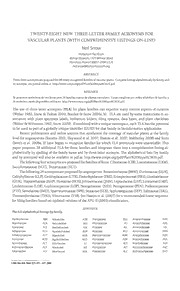
TWENTY-EIGHT NEW THREE-LETTER FAMILY ACRONYMS FOR VASCULAR PLANTS (WITH COMPREHENSIVE LISTINGS ON-LINE) PDF
Preview TWENTY-EIGHT NEW THREE-LETTER FAMILY ACRONYMS FOR VASCULAR PLANTS (WITH COMPREHENSIVE LISTINGS ON-LINE)
NEW TWENTY-EIGHT THREE-LETTER FAMILY ACRONYMS FOR VASCULAR PLANTS (WITH COMPREHENSIVE LISTINGS ON-LINE) Snow Neil Museum, Bishop 1525 Bernice Street Honolulu, Hawaii 968 7-2704 USA. 1 bishopmuseum.org :onps.org/pdf/Plant%20Keys/ACROS.pdf. RESUMEN ://www.conps.org/pdf/Plant%20Keys/ACROS.p many The use of three-letter acronyms (TLA) for plant families can expedite routine aspects of curation & & TLA (Weber 1982; Snow Holton 2000; Brasher Snow 2004a, are used by some institutions in as- b). with specimen herbarium and sociation plant labels, folders, filing systems, data bases, plant checklists & TLA Wittmann Snow (Weber 1992; 2009). combined with a unique namespace, each has the potential If be used unique (GUID) to as part of a globally identifier for that family in bioinformatics applications. and Recent publications online sources that synthesize the coverage of vascular plants the family at Heywood level for angiosperms (Stevens 2001; et 2007; Haston et 2007; Mabberley 2008) and ferns al. al. TLA (Smith et al. 2006a, b) have begun to recognize families for which previously were unavailable. This TLA paper proposes 28 additional for those families and integrates them into a comprehensive listing al- name phabetically by spelling of the family and by three-letter acronym. The alphabetical (by family lists and by acronym) be pdf http://www.conps.org/pdf/Plant%20Keys/ACROS.pdf. will also available in at: The following four acronyms are proposed for families of ferns: Cibotiaceae (CIB), Loxomataceae (LXM), Saccolomataceae (SCC), Tectariaceae (TCT). The following 24 acronyms are proposed for angiosperms: Brownlowiaceae (BRW), Durionaceae (DUR), Calophyllaceae (CLP), Centroplacaceae (CTR), Eremolepidaceae (ERE), Eriospermaceae (ERS), Guamatelaceae (GUA), Haptanthaceae (HAP), Hostaceae (HOS), Johnsoniaceae (JHN), Leptaulaceae (LEP), Limeaceae (LME), Linderniaceae (LDR), Lophiocarpaceae (LOP) Nesogenaceae (NES), Pentapetaceae (PEN), Pteleocarpaceae ? (PTE), Samolaceae (SMO), Sparrmanniaceae (SPR), Stixaceae (STX), Syphostegiaceae (SYP), Talinaceae (TAL), Thomandersiaceae (THO), Viburnaceae (VIB). See Haston et al. (2007) for a recommended linear sequence APG for filing families based on updated versions of the (2003) classification. II APPENDIX J. Bot. Res. Inst. Texas 3(1):; Journal of the Botanical Research Institute of Texas 3(1) BRX Cistaceae :eae aceae ceae eae BUD Cochlospermaceae CCH Dicrastylidacea ARD Buddlejaceae CHC ae Burmanniaceae Colchicaceae COL eae Burseraceae ARE Combretaceae Diegodendrace Commelinaceae BYB Dillemaceae Byblidaceae BYT CAB Dioscoreaceae CNV CAC Dipentodontac ASD Cactaceae Convolvulaceae COP CSL Dipsacaceae Caesalpiniaceae ASL CRD cu Cordiaceae Dipteridaceae Calceolariaceae ATL CRR Dipterocarpace Callitrichaceae COD Calochortaceae ASR Calophyllaceae APE i Calycanthaceae Corsiaceae DoZr CLC haceae Dracaenaceae Corynocarpaceae CPM COT Campynemataceae Costaceae Droseraceae AUS CRM Dryopteridacea CRU Dulongiaceae CUS Elodeaceae CTH Empetraceae Rhopalocarpaceae Roridulaceae PGY Ruppiaceae SAB Stixaceae Strasburgenaceae Strelitziaceae Streptochaetaceae Stromatopteridaceae SSP Taccaceae Tecophilaeaceae Tectariaceae Tepuianthaceae ich ac ge ;a< Schoepfiaceae Ternstroemiaceae Sciadopityaceae Thelypteridaceae TMD Theophrastaceae TEO Tremandraceae Umbelliferae Thismiaceae THS Tribelaceae TRB Urticaceae Thomandersiaceae THO Trichomanaceae TCM Uvulariaceae ACKNOWLEDGMENTS My New thanks to K. Richards (Landcare Research, Zealand), E. Haston (E) and W. Judd (FLAS) for their comments, and Al Schneider and the Colorado Native Plant Society agreeing post the complete to for to listings online. REFERENCES APG 2003. An update of the Angiosperm Phylogeny Group classification forthe orders and families of flower- II. APG Soc Linnaean :399-436. ing plants: Bot. 141 J. II. Brasher, J.W. and N. Snow. 2004a. Further updates to Weber's three-letter family acronym system. Taxon (online no version, http://www.botanik.univie.ac.at/iapt/taxon/index.htm). [online version longer available] An Brasher, J.W. and N. Snow. 2004b. online compilation: Weber's system of three-letter plant family acronyms. http://www.unco.edu/nhs/biology/environment/herbarium/acronyms.pdf. A Haston, Richardson, PR Stevens, M.W. Chase, and DJ. Harris. 2007. linear sequence of Angiosperm Phylogeny J.E. E., Group Taxon 56:7-12. families. II Heywood, V.H., R.K. Brummit, A. Culham, and 0. Seberg. 2007. Flowering plant families of the World. Royal Botanic Gardens, Kew. Mabberley, DJ. 2008. Mabberley's plant-book. Cambridge University Press, Cambridge. KM A Smith, A.R., Pryer, Schuettpetlz, Korall, H. Schneider, and P.G. Wolf. 2006a. classification for extant ferns. E. P. Taxon 55:705-731. new Smith, A.R., H.-P. Kreier, C.H. HauflerJ.A. Ranker, and H. Schneider. 2006b. Serpocaulon (Polypodiaceae), a genus segregated from Polypodium.Taxon 55:919-930. Snow, N. 2009. Checklist of vascular plants of the Southern Rocky Mountain Region. Version http://www.con 3. ps. org/pdf/Plant%20Lists/SRMRChecklist_2009_Version3_Final%20(2).pdf Snow, N. and N. Holton. 2000. Additions to Weber's three-letter family acronyms based on results of The Angio- sperm Phylogeny Group. Taxon 49:77-78. 2001 (and onwards). Angiosperm Phylogeny Website. Version June 2008. http://www.mobot.org/ Stevens, RF. 9, MOBOT/research/APweb/welcome.html Oct (accessed 10 2008). Mnemonic acronyms more Weber, W.A. 982. three-letter for the families of vascular plants: a device for effective 1 herbarium Taxon 31:74-88. curation. Weber, W.A. and R.C. Wittmann. 1992. Catalog of the Colorado flora: a biodiversity baseline. University Press of Colorado, Niwot.
